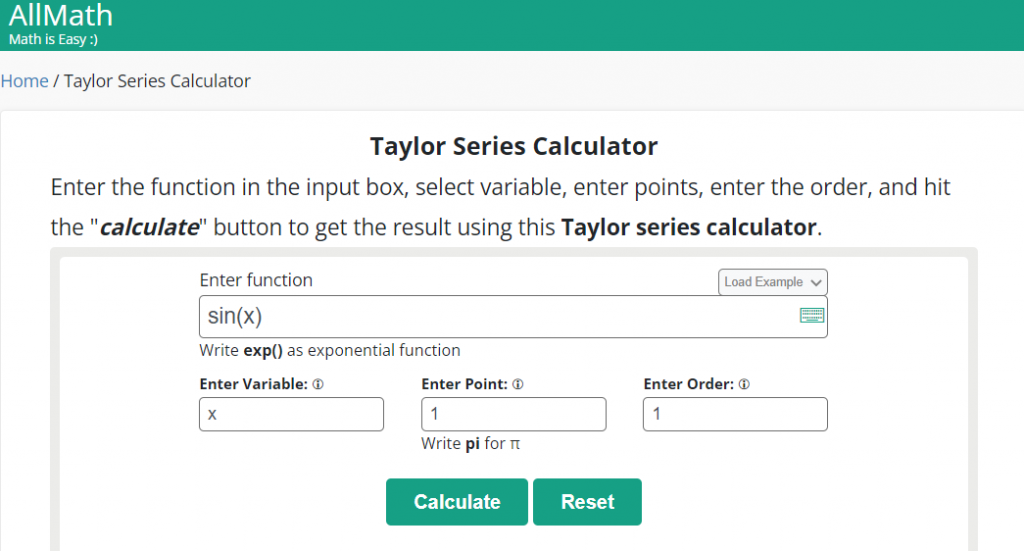
The Taylor series is one of the commonly used types of calculus. It is widely used to expand the functions up to the nth order around a specific point. It can expand the algebraic and trigonometric expressions with respect to single variable functions.
The limits and derivatives are involved in this branch of calculus to expand the function. Limits are used as a specific point of the function while the differential is used to find the derivatives of the function up to the nth order.
In this lesson, we are going to explain the definition and formula of the Taylor series and how to calculate it along with examples and solutions.
What is the Taylor series?
The Taylor series is a sub-branch of calculus and is defined as an expression of the given function f(x) whose derivatives exist up to nth order at a specific point “a” in the domain of “f” in the form of power series.
For expanding the functions, the Taylor series required a function f(x), an order of derivatives such as 1 for the first derivative, 2 for a second, and so on up to the nth order. And a particular point at which the function exists as a limit point.
If the function is non-continuous as there would be no derivative exists, then the Taylor series is not applied. So, for calculating the Taylor series, the function must be continuous.
Taylor Series Formula
The general expression to expand the function through the Taylor series is:
F(w) = f(b) + [f’(b) (w – b)]/ 1! + [f’’(b) (w – b)2]/ 2! + [f’’’(b) (w – b)3] / 3! + … + [f n (b) (w – b) n]/ n!
The summation form of the above equation is
F(w) = f n(b) (w – b) n/ n!
In the formula of the Taylor series,
- F(w) is the Taylor expansion of the given function.
- “b” is the particular point.
- “n” is the order of derivative.
- “f(b)” is the given function around the center point “b”.
A Taylor polynomial calculator is a helpful resource that can be used to expand the functions according to the above formula of the Taylor series.
Follow the below steps to calculate the Taylor series.
Step 1: Enter one variable algebraic or trigonometric function.
Step 2: Fill in the required input boxes such as the center point and the order of derivative.
Step 3: Click the calculate button.

How to calculate the Taylor series?
The formula of the Taylor series is a helpful way to calculate the Taylor series with some given information such as function, specific point, and the number of derivatives to be taken. Let us take a few examples to learn how to calculate the Taylor series.
Example 1: For trigonometric function
Expand the given trigonometric function whose particular point is 12 and the order is 5,
f(w) = sin(w) + cos(w) + 3w5
Solution
Step 1: First of all, take the given information about the function.
f(w) = sin(w) + cos(w) + 3w5
the nth term of the function= n = 5
center point = b = 12
Step 2: Now write the general expression of the Taylor sires that is helpful in expanding the function.
F(w) = f n(b) (w – b) n/ n!
Put n = 5 in the above summation form and write the series.
F(w) = f n(b) (w – b) n/ n!
F(w) = f(b) + [f’(b) (w – b)]/ 1! + [f’’(b) (w – b)2]/ 2! + [f’’’(b) (w – b)3] / 3! + [f’’’’(b) (w – b)4] / 4! + [fv(b) (w – b)5] / 5! … equation (1)
Step 4: Now take the first seven differentials of the given function.
f(w) = sin(w) + cos(w) + 3w5
f’(w) = d/dw [sin(w) + cos(w) + 3w5] = cos(w) + (-sin(w)) + 15w5-1 = cos(w) – sin(w) + 15w4
f’’(w) = d/dw [cos(w) – sin(w) + 15w4] = -sin(w) – cos(w) + 60w3
f’’’(w) = d/dw [-sin(w) – cos(w) + 60w3] = -cos(w) – (-sin(w)) + 180w2 = -cos(w) + sin(w) + 180w2
f’’’’(w) = d/dw [-cos(w) + sin(w) + 180w2] = -(-sin(w)) + cos(w) + 360w = sin(w) + cos(w) + 360w
f’’’’’(w) = d/dw [sin(w) + cos(w) + 360w] = cos(w) + (-sin(w)) + 360 = cos(w) – sin(w) + 360
Step 5: Now place “b” in the place of w to find f(b), f’(b), f’’(b), …
f(b) = sin(b) + cos(b) + 3b5
f’(b) = cos(b) – sin(b) + 15b4
f’’(b) = -sin(b) – cos(b) + 60b3
f’’’(b) = -cos(b) + sin(b) + 180b2
f’’’’(b) = sin(b) + cos(b) + 360b
f’’’’’(w) = cos(b) – sin(b) + 360
Step 5: Put n = 0, 1, 2, 3, 4, 5 in the summation form of the Taylor series to get the result of the series at specific point “b”.
For n = 0
f(b) (w – b)0/ 0! = f(b) = sin(b) + cos(b) + 3b5
For n = 1
f’(b) (w – b)1/ 1! = f’(b) (w – b) = [cos(b) – sin(b) + 15b4] (w – b)
For n = 2
f’’(b) (w – b)2/ 2! = f’’(b) (w – b)2/2 = 1/2 [-sin(b) – cos(b) + 60b3] (w – b)2
For n = 3
f’’’(b) (w – b)3/ 3! = f’’’(b) (w – b)3/6 = 1 /6 [-cos(b) + sin(b) + 180b2] (w – b)3
For n = 4
f’’’’(b) (w – b)4/ 4! = f’’’’(b) (w – b)4/24 = 1/24 [sin(b) + cos(b) + 360b] (w – b)4
For n = 5
f’’’’’(b) (w – b)5/5! = f’’’’’(b) (w – b)5/120 = 1 /120 [cos(b) – sin(b) + 360] (w – b)5
Step 6: Substitute all the values in equation (1).
F(w) = f(b) + [f’(b) (w – b)]/ 1! + [f’’(b) (w – b)2]/ 2! + [f’’’(b) (w – b)3] / 3! + [f’’’’(b) (w – b)4] / 4! + [fv(b) (w – b)5] / 5! … equation (1)
F(w) = [sin(b) + cos(b) + 3b5] + [[cos(b) – sin(b) + 15b4] (w – b)] + [1/2 [-sin(b) – cos(b) + 60b3] (w – b)2]+ [1 /6 [-cos(b) + sin(b) + 180b2] (w – b)3] + [1/24 [sin(b) + cos(b) + 360b] (w – b)4] + [1 /120 [cos(b) – sin(b) + 360] (w – b)5]
Step 7: Put b = 12 in the above expression.
F(w) = [sin(12) + cos(12) + 3(12)5] + [[cos(12) – sin(12) + 15(12)4] (w – 12)] + [1/2 [-sin(12) – cos(12) + 60(12)3] (w – 12)2]+ [1 /6 [-cos(12) + sin(12) + 180(12)2] (w – 12)3] + [1/24 [sin(12) + cos(12) + 360(12)] (w – 12)4] + [1 /120 [cos(12) – sin(12) + 360] (w – 12)5]
F(w) = [sin(12) + cos(12) + 746496] + [[cos(12) – sin(12) + 311040] (w – 12)] + [1/2 [-sin(12) – cos(12) + 103680] (w – 12)2]+ [1 /6 [-cos(12) + sin(12) + 25920] (w – 12)3] + [1/24 [sin(12) + cos(12) + 4320] (w – 12)4] + [1 /120 [cos(12) – sin(12) + 360] (w – 12)5]
Hence, the given function ycos(y) + 23 is expanded in a power series.
Final words
Now you can grab all the basics of calculating the Taylor series from this post. In this lesson, we have discussed all the basics of this topic along with the definition, formula, and solved example. Once you grab the basics of this post, you will master it.
